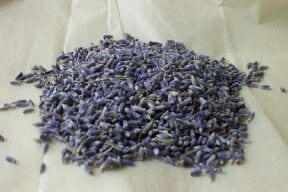Clothes moths are a common irritation traditionally remedied using dried lavender

I was watching TV the other night and saw a programme on the clothes moth. Apparently they originated in owl pellets! A human’s wardrobe can – it seems – be said to resemble an owl nest from the moth’s point of view! The larvae particularly like natural fibres to eat, such as wool, and leave tiny holes. The presenter of course recommended lavender bags to deter them.
Moth repellent tips using dried lavender

– Squeeze your lavender bag weekly to keep the strong scent which the moths hate (you can keep doing this for months with the same bag).
– Remember that moths are not killed by lavender bags, they just don’t like the smell – so if you have an infestation, the best thing to do is have a thorough clear out and clean. Then put the lavender bags in!- If you like to buy vintage or second hand jumpers, put them in the freezer for a few days to kill any pests.
– The cocoons of the larvae look like grains of rice, so look out for these at the back of the wardrobe.
ideas.) See my no sew lavender bag make

Other dried flowers as moth repellents
Wormwood (Artemisia) and cedar are both used traditionally as moth repellents. Cedar blocks are often threaded onto the top of a coathanger and are an elegant way of keeping the moths at bay. Wormwood is a common garden plant with a woody base, grown mostly for its attractive silvery foliage which can be easily dried at home. Wormwood is often combined with other dried flowers, herbs and essential oils in a sachet to go in the wardrobe.
See my new post on Cedarwood moth repellents
Shopping links for dried lavender
Buy fragrant lavender for use as a moth repellent